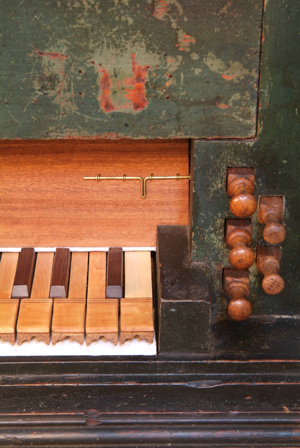 Sunday, 21 October, 6.00 p.m.
Sunday, 21 October, 6.00 p.m.
Hospice of Bom Jesus
Sérgio Silva, organ
Patrycja Gabrel, soprano
Carolina Figueiredo, mezzo-soprano
Ana Raquel Pinheiro, baroque ‘cello
The accession to the throne of King John V in 1707 marked an important moment in the history of Portuguese music. During his reign, the Royal Chapel was reformed, an institution for the teaching of music – the Patriarchal Seminary – and a school for the teaching of chant at the Convent of St Catherin of Ribamar were founded. At the same time, King John directed Portuguese musical life, with the absorption of the Italian musical style of the time, following the model of the Papal Chapel. The financial prosperity obtained by means of Brazilian gold permitted the allocation of very generous funds to the Royal Chapel, which were invested in the attribution of grants to Portuguese students, as was the case with António Teixeira, João Rodrigues Esteves and Francisco António de Almeida, as well as the hiring of singers from the Cappella Giulia itself.
Though he was not one of King John V’s grant holders, Carlos Seixas was, without a doubt, one of the most representative composers of his time. Known chiefly for his keyboard music, a number of choral pieces of his authorship are now known, such as the Christmas responsory Hodie nobis caelorum Rex.
António Teixeira, after having studied in Italy, was elected singer-chaplain at Lisbon Cathedral. A master of the Italianate musical style of the time, he left a series of responsories for the feast of St Vincent Martyr, patron saint of Lisbon, which include Tanta grassabatur crudelitas. Chapelmaster of the Basilica of St Mary the Greater in Lisbon and teacher at the Patriarchal Seminary, João Rodrigues Esteves was one of those awarded a grant to study in Italy. From the sequence Stabat Mater we will hear some excerpts for soprano and alto soloists and soprano and alto duet, in which the dramatic intensity is enhanced by the basso continuo. Appointed organist of the Royal Chapel, Francisco António de Almeida is known for his oratorios, operas and sacred motets. Awarded a grant to study in Italy by King John V, his first known compositions date precisely from this period. From the responsories Si quaeris miracula, for the feast of St Anthony, and In dedication temple, we hear the verses, both written for soprano and alto duet.
Concerning the lives of the composers Fr José da Madre de Deus, Fr Jerónimo da Madre de Deus and Fr Jacinto do Sacramento, no information survives, except for knowledge of the authorship of a small number of pieces. João de Sousa Carvalho began studying music at the renowned College of the Holy Kings at Vila Viçosa, but finished his studies in Naples, with authorization from the King. On his return to Lisbon, he became teacher of counterpoint at the Patriarchal Seminary, later becoming master and chapelmaster. The work Inter natos mulierum is an antiphon for the feast of the birth of St John the Baptist, and comprises two sections: the first setting the text on St John, and the second setting the Alleluia. Both show the composer’s virtuosic vocal writing, while never losing from sight the galant style.
Sérgio Silva
A journey through Portuguese sacred music of the 18th century
Carlos Seixas (1704 - 1742)
Responsory Hodie nobis cælorum Rex
Allegro
Affectuozo
Amorozo
Carlos Seixas
Sonata for organ in G major (organ solo)
António Teixeira (1707 - 1769?)
Responsory Tanta grassabatur crudelitas
Verso a duo
Carlos Seixas
Sonata for organ in A minor
Organ solo
João Rodrigues Esteves (c.1700 - d.1751)
Stabat Mater
Quis est homo, qui non fleret
Eja mater, fons amoris
Carlos Seixas
Sonata for organ in A minor ( organ solo)
João Rodrigues Esteves
Stabat Mater
Fac me vere 1
Virgo virginum præclara 2
Fr. José da Madre de Deus (séc. XVIII)
Fugue in D major (organ solo)
Fr. Jerónimo da Madre de Deus (1714/15-d.1768)
Sabbato Sancto ad Matutinum Lectio Octava 2
Carlos Seixas
Sonata for organ in A minor
Organ solo
Francisco António de Almeida (fl. 1722 - 1752)
Responsory Si quæris miracula
Verso a duo 1, 2
Carlos Seixas
Toccata in C major (organ solo)
Francisco António de Almeida
Responsory In dedicatione templi
Verso a duo 1, 2
Fr. Jacinto do Sacramento (1712-?)
Toccata in D minor (organ solo)
João de Sousa Carvalho (1745-1799/1800)
Inter natus mulierum 1, 2
Participants
|
Born in Lisbon, Sérgio Silva began to study organ at the Gregorian Institute of Lisbon, under João Vaz and António Esteirero. After finishing a degree in information technology and managment at the ISCTE, he took a licentiate degree in music, specifically in organ performance, at the University of Évora, under the supervision of João Vaz, on the theme “The tentosde meio registo and the batalhas of Pedro de Araújo: questons of authorship and critical edition”, under the suervision of João Vaz and João Pedro d’Alvarenga. In addition, his tradining was completed by his contact with internationally renowned musicians such as José Luís González Uriol, Luigi Ferdinando Tagliavini, Jan Wilhelm Jansen, Hans-Ola Ericsson and Kristian Olesen. He has performed as a soloist in various places in Portugal and in Spain, notably in the Lisbon International Organ Festival, the Organ Days in Saragossa and in the Inaugural Concerts of the Six Organs of the Royal Basilica of Mafra. As an ensemble player, he has collaborated with the Gulbenkian Orchestra, the Gulbenkian Choir, the Portuguese Symphony Orchestra, the Choir of the São Carlos National Theatre, Capella Patriarchal, Voces Caelestes, Introitus, Sete Lágrimas and others. He is currently professor of organ at the Gregorian Institute of Lisbon and at the Diocesan School of Sacred Music in Lisbon, and is titular organist of the Basílica da Estrela and the Church of St Nicholas (Lisbon). |
|
Patrycja Gabrel began her musical education at the age of seven, becoming a member, at eleven, of the Schola Cantorum Bialostociensis, one of the best female choirs in Poland. She graduated in singing from the Fryderyk Chopin Music Conservatory in Warsaw, and continued her training at the Escuela Superior Reina Sofia in Madrid under Tom Krause, also studying with Riri Greist, Teresa Berganza and Charles Kellis. Having been awarded grants from the Polish Ministry of Culture and the Escuela Superior Reina Sofia, she won the Alfredo Kraus Singing Prize for Young Musicians, and the Radio Poland 2 Prize in the “Art of Contemporary Song” competition. She has performed on all the main stages of Poland, including the Warsaw Opera Theatre and the Warsaw Philharmonia, and in halls in a number of European countries, such as the Auditorio Nacional in Madrid and the Palau de la Musicai n Barcelona. In Portugal, she first appeared in March 2011 in the Large Auditorium of the Gulbenkian Foundation, in the role of Solvei gin Greig’s Peer Gynt Suite, with the Gulbenkian Orchestra. She currently works with the Gulbenkian Choir. |
|
Studied singing at the Music School of the National Conservatory of Lisbon, in the class of Filomena Amaro in 2005. She now works regularly with Manuela de Sá. She has taken part in masterclasses and workshops with Lusica Mazzaria, Tom Krause and João Paulo Santos, and frequently attends workshops organized by the European Network of Opera Academies (ENOA) organized by the Gulbenkian Foundation. In concert, she has appeared as soloist in The Messiah by Handel, the Coronation Mass, the Missa Brevis in C major and the MIssa Brevis in G major by Mozart, the Te Deum by Sousa Carvalho, the Helingenmesse by Haydn, the Gloria by Vivaldi, a number of sacred works by Bach, Purcell, Schütz, Fauré, Francisco António de Almeida and Carlos Seixas. She also gives regular solo recitals of sacred music, both baroque and romantic. In opera, she has appeared in Bastien e Bastienne by Mozart (Bastien), Faust by Gounod (Marthe), Peer Gynt by Grieg (Shepherdess) and Turandot by Busoni (Vorsangerinnen). She has worked under the direction of Martin André, Moritz Gnann, Michael Corboz, Jorge Matta, António Lourenço, Jorge Alves and José Robert, in collaboration with the Divino Sospiro Orchestra, the Portuguese Symphony Orchestra, the Gulbenkian Orchestra, the Orchestra of the North and the Orchestra of the Algarve. Future projects include participation in Mozart’s Bastien et Bastienne (with the Orchestra of the North – November 2012), Alfredo Keil’s Irene (São Carlos National Theatre – November 2012), Monteverdi’s L’Orfeo (Ninfa) with the Divino Sospiro Orchestra (February 2013) and Respighi’s Il Tramonto, in the Gulbenkian Orchestra soloists’ cycle (June 2013). |
|
Began her ‘cello studies at the Professional Arts School of Beja Interior in the class of Rogério Peixinho. She received a licentiate in ‘cello at the Higher School of Applied Arts in the classes of Miguel Rocha and Catherine Stynckx. She studied baroque ‘cello at the Scuola Civica in Milan with Gaetano Nasillo, on a grant from the Gulbenkian Foundation. She attended masterclasses with the ‘cellists Márcio Carneiro, Jeroen Reulling, Xavier Gagne-Pan, Jian Wang, António Meneses, Elisa Joglar, Leonardo Luckert, Itziar Atutxa and Rainer Zipperling. She won the Second Prize in Class B of the Júlio Cardona String Competition in 2001. She teaches ‘cello at the St Cecilia Academy of Music in Lisbon. She collaborates regularly with orchestras such as Músicos do Tejo (Portugal), Musici di Santa Pelagia (Italy), Divina Armonia (Italy), La Risonanza (Italy) and the Divino Sospiro Baroque Orchestra (Portugal). She is currently completing a master’s degree in instrumental pedagogy at ANSO/ Universidade Lusíada, under the supervision of Paulo Gaio Lima. |
Notes about the Organ
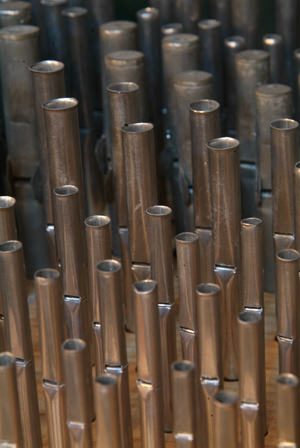 Hospice Bom Jesus, Funchal
Hospice Bom Jesus, Funchal
This small positive organ was built in 1781 by Leandro José da Cunha (b. 1743, d. after 1805), who was from Lisbon and was one of the three members identified as belonging to this family of organ builders. Leandro was the son of the builder João da Cunha (b. 1712, d.1762), also from Lisbon, who built the organ of the Church of Nossa Senhora da Luz, at Ponta do Sol.
It is an example of a type of instrument typical of Portuguese organs in the first half of the 18th century. The fact that the instrument did not originally possess a basic 8’ (12-palm) stop – like many other positives of the period – but only 4’ (6-palm), seems to indicate a musical practice that relied on reinforcement in the lower register through the use of another instrument.
Manual (C, D, E, F, G, A-d’’’)
Flautado de 6 tapado (4’)
Quinzena (2’)
Dezanovena (1 1/3’)
22ª e 26ª
Sesquialtera II ( )
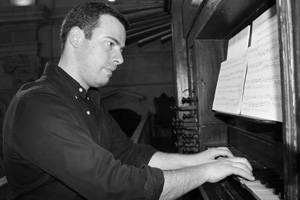 Sérgio Silva
Sérgio Silva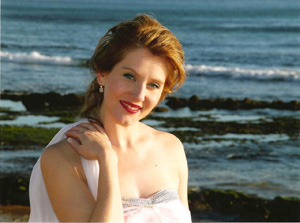 Patrycja Gabrel
Patrycja Gabrel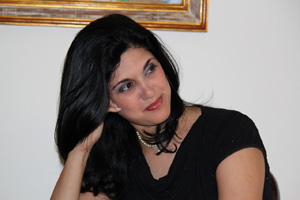 Carolina Figueiredo
Carolina Figueiredo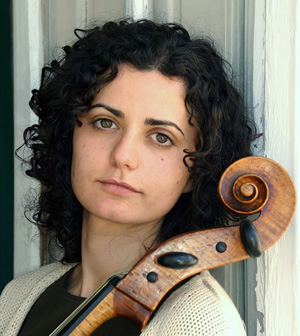 Ana Raquel Pinheiro
Ana Raquel Pinheiro